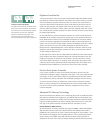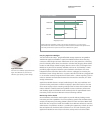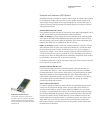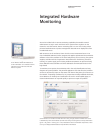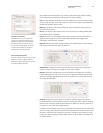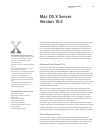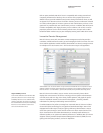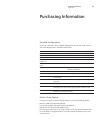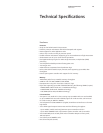
Mac OS X Server
Version 10.3
Xserve G5 ships with Mac OS X Server version 10.3, the fourth major release of Apple’s
award-winning server operating system. Mac OS X Server provides open source,
standards-based workgroup and Internet services without the complexity inherent
in Linux and other UNIX-based solutions. Hardware and software work together to
deliver powerful, scalable solutions for supporting Mac, Windows, and Linux work-
groups; deploying powerful Internet services; and hosting enterprise applications—all
with an ease of use that is uniquely Macintosh. And with the unlimited-client license,
there are no additional per-seat fees for connecting more users.
4
This kind of power
has never been easier to put to work—or easier to integrate into your organization.
Optimized for the PowerPC G5
On all systems, Mac OS X Server features a high-performance 64-bit file system that
supports HFS+ (and HFS+ journaled) file systems up to 16TB, so you can create very
large, single file systems for massive databases, image archives, and digital video
storage. In addition, Apple has written version 10.3 to take maximum advantage of the
PowerPC G5, enabling current 32-bit applications to benefit immediately from the key
advances of 64-bit processing. On PowerPC G5–based systems, Mac OS X Server can
utilize the processor’s 64-bit instructions and registers. It also includes 64-bit math
and vector libraries that accelerate audio, video, and image processing, as well as large
number operations—so existing applications that use these built-in libraries get an
automatic performance boost.
Mac OS X Server v10.3 can address the 4TB of physical memory supported by the
PowerPC G5. To ensure binary compatibility with existing 32-bit applications, Mac OS
X manages access to the 64-bit physical memory space using a 32-bit virtual memory
manager. This enables each Mac OS X application to access 4GB of address space,
allowing multiple memory-intensive applications to run concurrently. For improved
performance, data-intensive applications that require more than 4GB of memory can
map pages of memory using the built-in mmap function.
Performance gains are even more dramatic when applications, particularly compute-
intensive applications, are recompiled for the PowerPC G5. Using Xcode and GCC (GNU
Compiler Collection) version 3.3, developers can get improved code generation that
keeps the processor’s integer and floating-point units constantly fed with instructions.
Built-In Network Services
Mac OS X Server includes a complete suite of robust solutions for file and print,
Internet and web, networking, workgroup management, and directory services. Apple
has integrated and tested the latest open source technologies—such as OpenLDAP,
Postfix, Apache, and JBoss—making them easy to deploy right out of the box.
22
Technology Overview
Xserve G5
New in Mac OS X Server version 10.3
The latest release of Mac OS X Server has
more than 150 new features, including:
• PowerPC G5–optimized kernel and
numerical libraries
• Automatic Setup for configuring multiple
servers
• Server Admin application for easy setup
and monitoring of services
• Open Directory 2 for delivering enterprise
directory and authentication services
• Single sign-on using Kerberos v5
• Samba 3 for supporting Windows users
• Postfix mail server for Mac and Windows
users
• VPN server for Mac and Windows users
• JBoss application server for running
J2EE-based applications
New in Mac OS X Server for Xserve G5
• 802.1q VLAN support
• Background rebuilding of software
RAID mirrors
• RAID volume promotion
• Enhanced UPS support
• Enhanced Server Monitor
• Customizable keyboard and mouse
security options
• Xserve Remote Diagnostics



